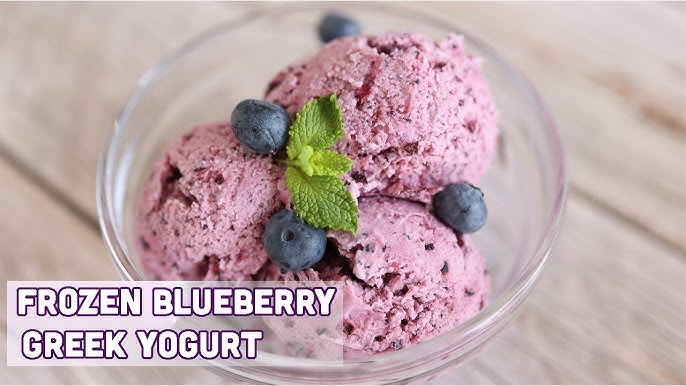Frozen Yogurt Recipe: Who doesn’t love a scoop of tangy, creamy frozen yogurt on a hot day—or any day, really? Whether you’re health-conscious, lactose-sensitive, or just in love with DIY desserts, frozen yogurt is an easy win.
In this guide, you’ll learn how to whip up your very own frozen yogurt at home with simple steps and easily available ingredients. The best part? You get to control everything that goes into your delicious treat.
What is Frozen Yogurt?
Frozen yogurt, also known as “froyo,” is a frozen dessert made primarily from yogurt and sometimes combined with milk or cream. It’s similar to ice cream but packs a slightly tangier taste thanks to the active bacterial cultures in the yogurt. It’s often perceived as the healthier cousin of ice cream—less fat, fewer calories, and some added probiotics if you use live-culture yogurt.
Unlike traditional ice cream, which uses heavy cream and eggs, frozen yogurt relies on yogurt’s natural richness and tang. That makes it ideal for people who want a lighter dessert or have mild lactose intolerance.
It gained traction in the U.S. during the health-food movement of the 1980s, and ever since, frozen yogurt has taken off in cafes, grocery store aisles, and home kitchens alike.
Benefits of Homemade Frozen Yogurt
Making your own frozen yogurt comes with a truckload of perks. For starters, you know exactly what’s going into your dessert. No preservatives, no artificial colors, and definitely no hidden sugars.
Here are some sweet benefits:
- Healthier Options: You can choose low-fat or Greek yogurt for a high-protein version. You’re also in control of the sugar—use honey, agave, or even zero-calorie sweeteners if that’s your thing.
- Custom Flavors: Fancy strawberry-basil? How about lemon-lavender or coffee-chip? You’re only limited by your imagination (and maybe your spice rack).
- Budget-Friendly: A tub of good-quality froyo can set you back quite a bit. With homemade, you get a full batch at a fraction of the price.
- Diet-Friendly: Whether you’re keto, vegan, or gluten-free, there’s a version of frozen yogurt for you. You can swap out dairy for almond or coconut yogurt, or use stevia instead of sugar.
Homemade frozen yogurt isn’t just a dessert—it’s a creative project with a tasty reward at the end.
Ingredients You’ll Need
The basic frozen yogurt recipe calls for just three ingredients. Yes, really—just three. Here they are:
Basic Ingredients:
- 2 cups of plain or Greek yogurt (full-fat for creamier results)
- ½ cup of sweetener (sugar, honey, maple syrup, or agave)
- 1 tsp of vanilla extract (optional, but adds flavor depth)
Optional Add-ins:
- Fresh fruits like strawberries, blueberries, or mango
- Swirls of peanut butter or chocolate sauce
- Crushed cookies or granola for texture
- A pinch of salt to enhance flavors
- Lemon or lime zest for brightness
You can also play around with flavored yogurts, but be careful—they often come with added sugars and artificial flavoring. If you’re going for a purist, natural approach, start with plain yogurt and build your flavors from there.
Equipment Needed
Before you dive in, let’s talk gear. The good news is, you don’t need any fancy equipment to make frozen yogurt. In fact, you can make it with or without an ice cream maker.
Must-Have Tools:
- Mixing bowl: For combining all your ingredients.
- Whisk or electric mixer: To blend the yogurt and sweetener smoothly.
- Freezer-safe container: For storing the final product.
- Spoon or spatula: For stirring and scooping.
Nice-to-Have Gadgets:
- Ice cream maker: This gives you a smoother, creamier texture without the wait. If you plan to make frozen desserts regularly, it’s a solid investment.
- Blender or food processor: Especially useful if you’re adding fruits or mix-ins that need pureeing.
Even if you don’t have an ice cream maker, don’t worry. A little patience and a couple of stirs during freezing will still yield delicious results.
Step-by-Step Guide to Making Frozen Yogurt
Making frozen yogurt at home is easy, fun, and totally customizable. Here’s a step-by-step breakdown:
Step 1: Prepare Your Yogurt Base
Start with high-quality yogurt. If you want a thicker, creamier texture, go with full-fat Greek yogurt. For a lighter option, you can use low-fat or even non-dairy alternatives like almond or coconut yogurt. Place 2 cups of yogurt into a large mixing bowl.
Add your sweetener of choice—this could be white sugar, honey, maple syrup, or agave. Start with ½ cup and taste as you go. Some yogurts are tangier than others and may require a bit more sweetness. Add a teaspoon of vanilla extract to elevate the flavor and stir thoroughly until the mixture is smooth and consistent.
Step 2: Chill the Mixture
Place the bowl in the fridge for at least an hour. This step is crucial if you’re using an ice cream maker, as it helps the machine freeze the mixture faster and more evenly. If you’re not using an ice cream maker, chilling still improves the final texture.
Step 3: Churn or Stir
If you’re using an ice cream maker, pour the chilled mixture in and churn according to your machine’s instructions (usually 20-25 minutes). You’ll know it’s done when it reaches a soft-serve consistency.
No machine? No problem. Pour the mixture into a freezer-safe container and place it in the freezer. Every 30 minutes for the next 2-3 hours, stir it thoroughly with a fork or whisk. This breaks up ice crystals and gives you that creamy texture you’re after.
Step 4: Add Mix-ins (Optional)
Once your frozen yogurt is semi-frozen, you can fold in your favorite mix-ins—think crushed Oreos, chopped nuts, swirls of jam, or chocolate chips. Just make sure they’re evenly distributed.
Step 5: Final Freeze and Serve
After your last stir or churn, let the frozen yogurt sit in the freezer for another hour or so to firm up. When ready to serve, take it out and let it sit at room temperature for 5-10 minutes to soften slightly. Scoop, serve, and enjoy!
Flavor Variations to Try
Here are some fun frozen yogurt flavor ideas you can try once you’ve mastered the basic recipe:
- Strawberry Delight: Blend in fresh strawberries or strawberry puree before freezing.
- Tropical Twist: Add coconut yogurt, pineapple chunks, and a hint of lime zest.
- Chocolate Fudge: Mix in cocoa powder, chocolate chips, and a swirl of chocolate syrup.
- Peanut Butter Banana: Blend ripe banana and swirl in peanut butter for a protein-packed treat.
- Mint Chocolate Chip: Add peppermint extract and mini chocolate chips for a fresh and classic combo.
Tips for the Creamiest Frozen Yogurt
Even though frozen yogurt is naturally tangy and a bit less creamy than ice cream, there are ways to enhance the texture:
- Use full-fat yogurt for a smoother result.
- Strain your yogurt using a cheesecloth if it’s too watery.
- Add a bit of corn syrup or alcohol (like vodka) to prevent it from freezing too hard.
- Don’t skip the stirring if you’re making it without a machine—it’s the secret to creaminess.
Common Mistakes to Avoid
Even though frozen yogurt is simple to make, here are a few rookie mistakes you’ll want to avoid:
- Using non-fat yogurt: This often leads to icy texture. A bit of fat helps keep things smooth.
- Over-sweetening: The freezing process dulls sweetness, but be cautious. It’s easier to add more sweetener later than to fix an overly sugary mix.
- Skipping the chilling step: If your base isn’t cold enough, it won’t freeze properly in the machine.
- Freezing too long: Homemade frozen yogurt hardens more than store-bought. Eat it fresh or give it time to soften before scooping.
Storing Your Homemade Frozen Yogurt
Homemade frozen yogurt should be stored in an airtight container in the coldest part of your freezer. Place plastic wrap or wax paper directly on the surface before sealing to avoid ice crystals forming. It’s best enjoyed within 2 weeks, as it tends to get icier over time.
Pro tip: Label your container with the flavor and date. Trust me, you’ll want to know which flavor you’re digging into!
Nutritional Facts and Health Benefits
Frozen yogurt can be a smart treat when made at home with clean, simple ingredients. Depending on your choice of yogurt and sweeteners, it can serve as a light dessert that doesn’t sabotage your healthy eating habits.
Here’s what you typically get in a ½ cup serving:
| Nutrient | Approximate Amount |
|---|---|
| Calories | 100–150 kcal |
| Protein | 4–8 g |
| Carbohydrates | 15–25 g |
| Sugar | 10–18 g |
| Fat | 1–5 g |
| Calcium | 10–15% RDI |
| Probiotics | Varies (if live cultures are used) |
These numbers vary depending on your ingredients. For instance, Greek yogurt has higher protein, and using fruit purées instead of sugar can lower the calorie count. Also, using live-culture yogurt means you’re getting those gut-friendly probiotics, which help digestion and boost your immune system.
Some major health benefits of homemade frozen yogurt:
- Probiotics: When you use live-culture yogurt, you’re giving your digestive system a boost.
- High in Protein: Especially with Greek yogurt, frozen yogurt can be a solid source of protein.
- Calcium-Rich: Supports bone health and muscle function.
- Lower Fat Option: Compared to traditional ice cream, froyo is typically lighter in fat and calories.
- Customizable to Dietary Needs: Dairy-free, sugar-free, keto—you name it, you can adapt the recipe.
So, yes—you can totally indulge without the guilt!
Vegan and Dairy-Free Options
No dairy? No problem. You can still enjoy frozen yogurt with plant-based alternatives. Here’s how to go dairy-free without compromising taste or texture.
Best yogurt substitutes for vegan frozen yogurt:
- Coconut milk yogurt: Rich and creamy with a slight tropical flavor.
- Almond milk yogurt: Lighter with a subtle nutty taste.
- Soy milk yogurt: Neutral in flavor and higher in protein.
- Cashew yogurt: Ultra-creamy and great for mimicking dairy-based froyo.
Sweetener alternatives for vegans:
- Maple syrup
- Agave nectar
- Coconut sugar
- Date syrup or blended Medjool dates
When making vegan froyo, the biggest challenge is creaminess. Coconut cream or a splash of plant-based milk can help fix that. You might also want to add a little bit of xanthan gum or arrowroot powder to prevent it from becoming icy.
And yes, vegan frozen yogurt can still taste just as amazing—think mango coconut, chocolate almond, or raspberry lime.
Best Toppings for Frozen Yogurt
What’s frozen yogurt without a mountain of toppings, right? While the yogurt is the star, toppings take it from good to unforgettable.
Healthy topping ideas:
- Fresh fruits (strawberries, mango, kiwi)
- Chia seeds
- Crushed nuts (almonds, walnuts, pistachios)
- Unsweetened shredded coconut
- Dark chocolate shavings
Decadent treat toppings:
- Mini marshmallows
- Chocolate chips
- Cookie crumbles
- Caramel or chocolate sauce
- Sprinkles
Fun combos to try:
- Tropical Mix: Pineapple + coconut flakes + macadamia nuts
- Chocolate Crunch: Brownie bits + chocolate sauce + almonds
- Berry Bliss: Blueberries + granola + honey drizzle
When adding toppings, do it just before serving. It keeps everything fresh, crunchy, and picture-perfect.
Frozen Yogurt vs. Ice Cream vs. Gelato
Let’s clear up the differences between these frozen treats. They may all seem similar, but their ingredients and textures tell a different story.
| Feature | Frozen Yogurt | Ice Cream | Gelato |
|---|---|---|---|
| Base Ingredients | Yogurt | Cream, milk, sugar | Milk, less cream |
| Fat Content | Lower | Higher | Moderate |
| Texture | Light and tangy | Creamy and rich | Dense and smooth |
| Calories | Lower per serving | Higher | Moderate |
| Probiotics | Yes (with live cultures) | No | No |
| Taste | Tangy and refreshing | Sweet and creamy | Rich and intense |
Each has its charm, but frozen yogurt stands out as the everyday hero—healthier, customizable, and oh-so-easy to make at home.
Frozen Yogurt for Special Diets
Whether you’re counting carbs, avoiding dairy, or going gluten-free, there’s a frozen yogurt variation for you. Here’s how to tweak your froyo to fit your lifestyle.
Keto-Friendly Frozen Yogurt
- Use full-fat Greek yogurt (unsweetened)
- Sweeten with erythritol or monk fruit
- Add vanilla extract or cocoa powder for flavor
- Churn or stir until soft-serve texture forms
Low-Calorie or Weight-Loss-Friendly Froyo
- Opt for low-fat yogurt
- Use fruit purée or stevia instead of sugar
- Add fiber with flaxseed, chia, or psyllium husk
- Limit calorie-dense toppings like syrups or candy
Gluten-Free Frozen Yogurt
- Most frozen yogurts are naturally gluten-free
- Watch for cross-contamination in toppings
- Stick to fresh fruits, nuts, and gluten-free granola
Diabetic-Friendly Froyo
- Use low glycemic sweeteners like xylitol or stevia
- Avoid sweetened condensed milk or high-sugar mix-ins
- Monitor carb intake by calculating your yogurt and fruit choices
Making frozen yogurt for dietary needs isn’t just possible—it’s actually fun. You get full control and peace of mind, knowing exactly what you’re scooping into your bowl.
Serving Ideas for Frozen Yogurt
Want to take your frozen yogurt game to the next level? These fun serving ideas will turn an ordinary dessert into a crowd-pleasing masterpiece.
1. Frozen Yogurt Parfaits Layer frozen yogurt with granola, fresh berries, and a drizzle of honey in a mason jar. It’s part breakfast, part dessert, and 100% delicious.
2. Froyo Sandwiches Spread frozen yogurt between two cookies and freeze until firm. A cool twist on a classic ice cream sandwich.
3. Froyo Pops Pour the mixture into popsicle molds, insert sticks, and freeze overnight. Great for kids and summer parties.
4. DIY Froyo Bar Hosting a get-together? Set up a froyo bar with different flavors, toppings, and sauces. Let your guests build their own bowls.
5. Chocolate-Dipped Froyo Bites Scoop mini balls of frozen yogurt, freeze until firm, then dip in melted dark chocolate. Add crushed nuts or coconut for extra flair.
Frozen yogurt doesn’t have to be boring. Dress it up and have fun with it!
Troubleshooting Common Issues
Even the best home chefs can run into a few hiccups. Here’s how to fix the most common froyo fails:
Too Icy?
- Use full-fat yogurt or add a bit of corn syrup
- Stir frequently during the freezing process
Too Sour?
- Add more sweetener or a splash of vanilla
- Use milder-flavored yogurt
Too Soft?
- Freeze for an additional hour
- Make sure your freezer is set at the proper temperature
Not Creamy Enough?
- Use Greek yogurt or strain regular yogurt
- Avoid over-mixing after freezing
Remember: practice makes perfect. The more you experiment, the better your results will get.
FAQs about Frozen Yogurt Recipe
Q1: Can I make frozen yogurt without an ice cream maker?
Yes! You can absolutely make frozen yogurt without an ice cream maker. Just mix your ingredients, freeze them in a shallow dish, and stir every 30 minutes for a few hours to break up ice crystals. It’s a bit more hands-on, but the result is still creamy and delicious.
Q2: What type of yogurt works best for frozen yogurt?
Plain Greek yogurt is ideal—it’s thick, creamy, and has a higher protein content. It also gives your frozen yogurt that tangy, signature taste. Avoid flavored or low-fat yogurts if you want full control over sweetness and texture.
Q3: How long does homemade frozen yogurt last in the freezer?
Homemade frozen yogurt can last up to 2 weeks in the freezer. Just be sure to store it in an airtight container to prevent freezer burn. After the first few days, the texture might firm up, so let it sit at room temp for 5–10 minutes before scooping.
Q4: Can I sweeten my frozen yogurt naturally?
Absolutely! You can use honey, maple syrup, agave, or even mashed ripe bananas as natural sweeteners. They add flavor and help maintain that smooth, scoopable texture.
Q5: Is frozen yogurt healthier than ice cream?
Generally, yes. Frozen yogurt typically contains less fat and fewer calories than traditional ice cream, especially if made with low-fat or Greek yogurt. But keep an eye on added sugars—some store-bought versions sneak in a lot of them.
Q6: Can I add mix-ins like fruit or chocolate chips?
Totally! Add your favorite mix-ins like berries, crushed cookies, granola, or dark chocolate chips once the yogurt starts to firm up during churning (or halfway through freezing if you’re using the manual method). That way, they stay evenly distributed.
Conclusion
Frozen yogurt is more than just a trendy dessert—it’s a canvas for creativity, a healthier alternative to ice cream, and a fun kitchen project for all ages. With just a few ingredients and a little patience, you can craft a froyo masterpiece that suits your taste, dietary needs, and imagination.
Whether you’re going fruity, chocolatey, nutty, or somewhere in between, frozen yogurt offers endless possibilities. So why not grab that bowl of yogurt sitting in your fridge and get started today? Once you try homemade froyo, there’s no turning back!



